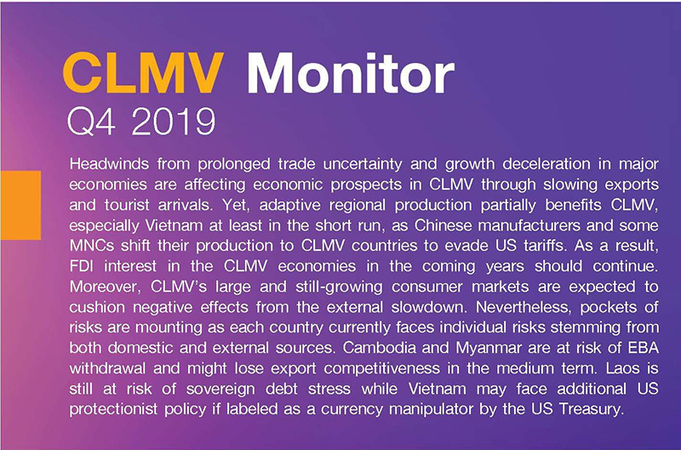Amid mounting risks, CLMV to witness 6-7% growth in 2020: SCB centre
However, adaptive regional production will partially benefit the bloc, especially Vietnam, at least in the short run, as Chinese manufacturers and some multinational corporations shift their production to CLMV countries to evade US tariffs.
As a result, foreign direct investment in CLMV economies in the coming years should continue, the centre said.
Moreover, consumption in the bloc and growing consumer markets are expected to cushion the negative effects from an external slowdown.
However, pockets of risks are mounting as each country currently faces individual risks stemming from both domestic and external sources.
Cambodia and Myanmar are at risk of Everything But Arms (EBA) withdrawal by the European Union and might lose their export competitiveness in the medium term.
Laos is still at risk of sovereign debt stress while Vietnam may face additional US action if labelled a currency manipulator by the US Treasury.
Vietnam is expected to grow at 6.7 per cent in 2020, supported by both domestic demand and exports.
With slowing exports and mounting external risks from US protectionist policies, private consumption should support growth from a strong labour market and moderate inflation.
Meanwhile, continued structural reforms should help spur both private and foreign investment in the country.
Cambodia’s growth is expected to moderate to 6.8 per cent in 2020 due to slow global trade.
Tourism and FDI grew at a slower rate, but the country’s fiscal situation and exports remained strong.
Still, the EBA withdrawal risk remains high and may affect exports to the European Union, Cambodia’s largest export market. Its fast-growing microfinance in household loans may also undermine its future financial stability and consumption outlook.
Laos’s economy is projected to recover to 6.5 per cent in 2020.
Overall economic activity slowed due to the effects of natural disasters in 2018, the trade war, and a China slowdown.
Meanwhile, Laos’s short-term vulnerabilities include limited foreign reserves and fiscal stress from low revenue in tax collection. However, future infrastructure and hydro projects, and policy reforms should boost the economy in the medium term.
Myanmar’s economy is expected to grow by 6.3 per cent in 2020 amid domestic risks before an election next year.
Recent FDI fell considerably, but ongoing policy reforms, continued financial liberalisation and foreign investment from other Asian countries should support its economic recovery. But downside risks come from the unsolved Rohingya crisis as Myanmar is also at risk in the event of an EBA withdrawal.
Source: https://www.nationthailand.com/business/30379508?utm_source=category&utm_medium=internal_referral


 Thailand
Thailand




